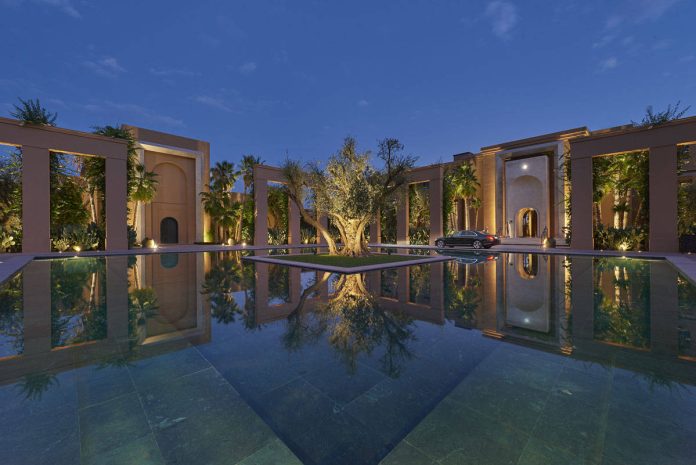A luscious 20-hectare park, designed as a huge garden and a paradise of vegetation, is the authentic sign of luxury that marks the first approach to the new Mandarin Oriental resort, opened in Marrakech last October, the Asian chain’s first investment in Africa. The access road is distinguished by an avenue shaded by palm trees and small dunes, while the rest of the garden, which is traversed by long footpaths, boast oranges, almonds, bougainvillea, jasmine, pink geraniums, oleanders, cactuses, rickly pears and thirty different rose varieties. There are even century-old olive trees ready for picking, which come from the Atlas mountains that rise up in the distance, as well as a large vegetable garden cultivated organically that produces fruit and vegetables used in the hotel kitchen.
Spacious buildings are dispersed among the brilliant colours of the blooms and lush greenery, with receptions, suites and restaurants, the reflective water of the swimming pools, the 54 private villas and the spa, all featuring low architecture with simple volumes.
Designed by the architect Pascal Desprez, they feature the reddish ochre colour of the characteristic Morocco earth. They are created with traditional local building materials and offer large glazed and terraced fronts that enhance the relationship between inside and outside, light and shadow.
Natural elements – earth, water, light and vegetation – are the starting point for the whole of the hotel project, the guide and material spectrum for the interior design concept completed by the French duo (Patrick) Gilles & (Dorothée) Boissier, who achieved outstanding results in their design of the villas and the spa.
In a mix of intimate and contemplative spaces, contemporary aesthetics and North African charm, the French firm, which drew on the richness of the local culture and history, was inspired by the Berber or Arab-Andalusian civilization rather than by Moroccan culture which is better-known and more recognizable.
The villas (from 280 to 440 sq m) are places of quiet and luxury, closed-off from the outside world, but airy inside and permeable like small riads: the master bedroom, guest bedroom, living room with a fireplace, dressing room, bathroom and hammam are arranged around a garden of fruit trees with a swimming pool and hot tub. And there is even a kitchen in the outdoor. The finishes and décor are precious, but by no means contrived: pale stone for contrasting floors with a dark tone for furnishings and louvered doors, black marble and glossy white ceramic in the bathrooms, traditional Beni Ourain black and white wool rugs with graphic decorations that reflect the special treatment of the walls. In addition to the tadelakt technique, the neutral surfaces of walls are enriched in a number of ways by decorative carvings rather than colour, which create true ‘stone tapestries’. Tadelakt finishes are achieved using an ancient Berber technique, with a lime base produced in the ancient wood-burning furnaces of Marrakech, which are now used to create smooth, polished, highly water-resistant surfaces.
More Andalusian influences are evident in the almost mystical architecture of the building that houses the spa: a tribute to the Moorish mosques and cathedrals, the red earth brick vaults and columns form high corridors and rooms of different sizes for the six suites dedicated to treatments, the hammams and the gym. Everything is embellished by reflections generated by the water of the large pool and the light that penetrates the mashrabiyas. There is a sumptuous twotone ivory and black marble floor, which is repeated in the lobby. “We are great admirers of the Ben Youssef Madrasa in Marrakech, and we wanted to create similar perfect symmetry for the lobby, with columns and dark wooden cornices, marble tiles, a mirror of water with golden reflections, fireplaces, bronze bells and a view of the mountains in the background.”
The Mandarin Oriental is part of the collection Contract&Hospitality – Spring/Sumer Book 2016 by IFDM, also available in digital version.
Credits:
Ownership: Park Palmeraie S.A.
Managing firm: Mandarin Oriental Hotel Group
Architecture: Pascal Desprez
Interior designers: Gilles & Boissier
Photo credits: Saad Tazi and Mandarin Oriental Hotel Group







